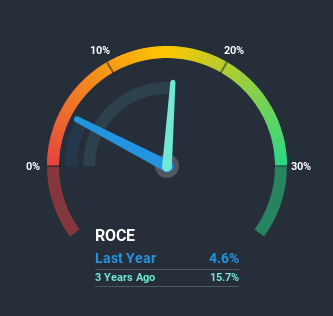- Saudi Arabia
- /
- Healthcare Services
- /
- SASE:4009
Middle East Healthcare (TADAWUL:4009) Will Will Want To Turn Around Its Return Trends

What trends should we look for it we want to identify stocks that can multiply in value over the long term? Typically, we'll want to notice a trend of growing return on capital employed (ROCE) and alongside that, an expanding base of capital employed. Ultimately, this demonstrates that it's a business that is reinvesting profits at increasing rates of return. However, after briefly looking over the numbers, we don't think Middle East Healthcare (TADAWUL:4009) has the makings of a multi-bagger going forward, but let's have a look at why that may be.
What is Return On Capital Employed (ROCE)?
For those that aren't sure what ROCE is, it measures the amount of pre-tax profits a company can generate from the capital employed in its business. To calculate this metric for Middle East Healthcare, this is the formula:
Return on Capital Employed = Earnings Before Interest and Tax (EBIT) ÷ (Total Assets - Current Liabilities)
0.046 = ر.س126m ÷ (ر.س4.0b - ر.س1.2b) (Based on the trailing twelve months to December 2020).
So, Middle East Healthcare has an ROCE of 4.6%. In absolute terms, that's a low return and it also under-performs the Healthcare industry average of 7.2%.
View our latest analysis for Middle East Healthcare

In the above chart we have measured Middle East Healthcare's prior ROCE against its prior performance, but the future is arguably more important. If you'd like, you can check out the forecasts from the analysts covering Middle East Healthcare here for free.
What Does the ROCE Trend For Middle East Healthcare Tell Us?
When we looked at the ROCE trend at Middle East Healthcare, we didn't gain much confidence. Over the last five years, returns on capital have decreased to 4.6% from 23% five years ago. Although, given both revenue and the amount of assets employed in the business have increased, it could suggest the company is investing in growth, and the extra capital has led to a short-term reduction in ROCE. And if the increased capital generates additional returns, the business, and thus shareholders, will benefit in the long run.
While on the subject, we noticed that the ratio of current liabilities to total assets has risen to 30%, which has impacted the ROCE. Without this increase, it's likely that ROCE would be even lower than 4.6%. Keep an eye on this ratio, because the business could encounter some new risks if this metric gets too high.
The Bottom Line
While returns have fallen for Middle East Healthcare in recent times, we're encouraged to see that sales are growing and that the business is reinvesting in its operations. However, despite the promising trends, the stock has fallen 37% over the last three years, so there might be an opportunity here for astute investors. So we think it'd be worthwhile to look further into this stock given the trends look encouraging.
If you want to continue researching Middle East Healthcare, you might be interested to know about the 2 warning signs that our analysis has discovered.
For those who like to invest in solid companies, check out this free list of companies with solid balance sheets and high returns on equity.
If you decide to trade Middle East Healthcare, use the lowest-cost* platform that is rated #1 Overall by Barron’s, Interactive Brokers. Trade stocks, options, futures, forex, bonds and funds on 135 markets, all from a single integrated account. Promoted
New: Manage All Your Stock Portfolios in One Place
We've created the ultimate portfolio companion for stock investors, and it's free.
• Connect an unlimited number of Portfolios and see your total in one currency
• Be alerted to new Warning Signs or Risks via email or mobile
• Track the Fair Value of your stocks
This article by Simply Wall St is general in nature. It does not constitute a recommendation to buy or sell any stock, and does not take account of your objectives, or your financial situation. We aim to bring you long-term focused analysis driven by fundamental data. Note that our analysis may not factor in the latest price-sensitive company announcements or qualitative material. Simply Wall St has no position in any stocks mentioned.
*Interactive Brokers Rated Lowest Cost Broker by StockBrokers.com Annual Online Review 2020
Have feedback on this article? Concerned about the content? Get in touch with us directly. Alternatively, email editorial-team (at) simplywallst.com.
About SASE:4009
Middle East Healthcare
A healthcare provider, owns and operates a network of hospitals under the Saudi German Hospital name in the Middle East and North Africa.
Proven track record and fair value.
Market Insights
Community Narratives



